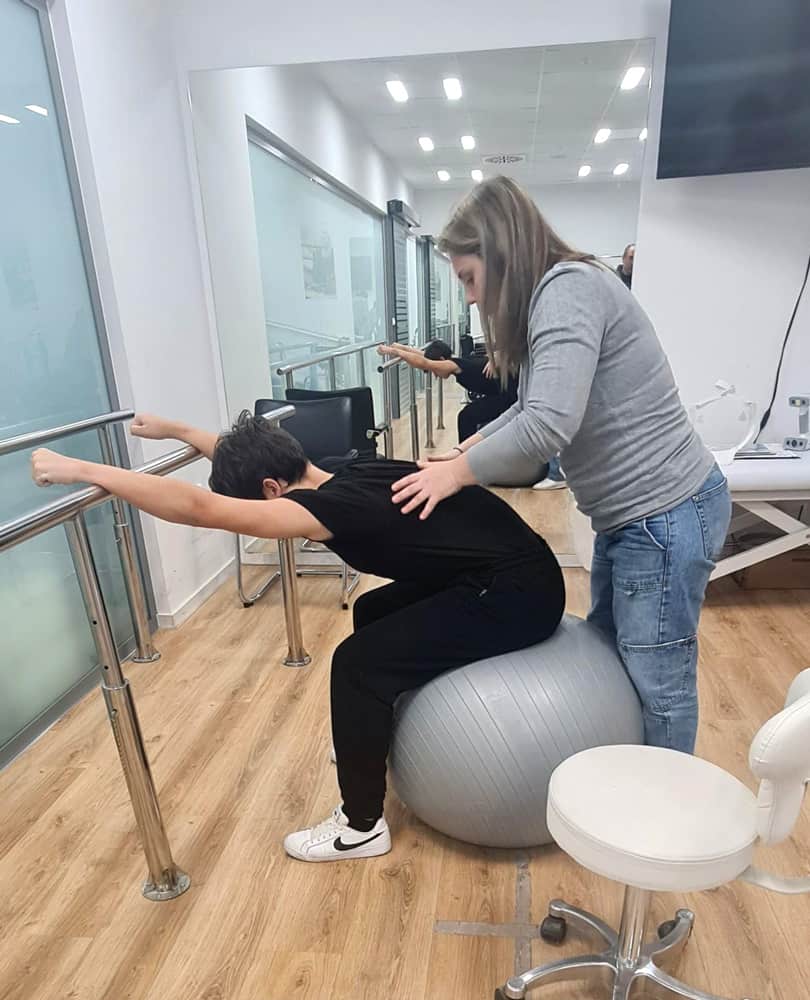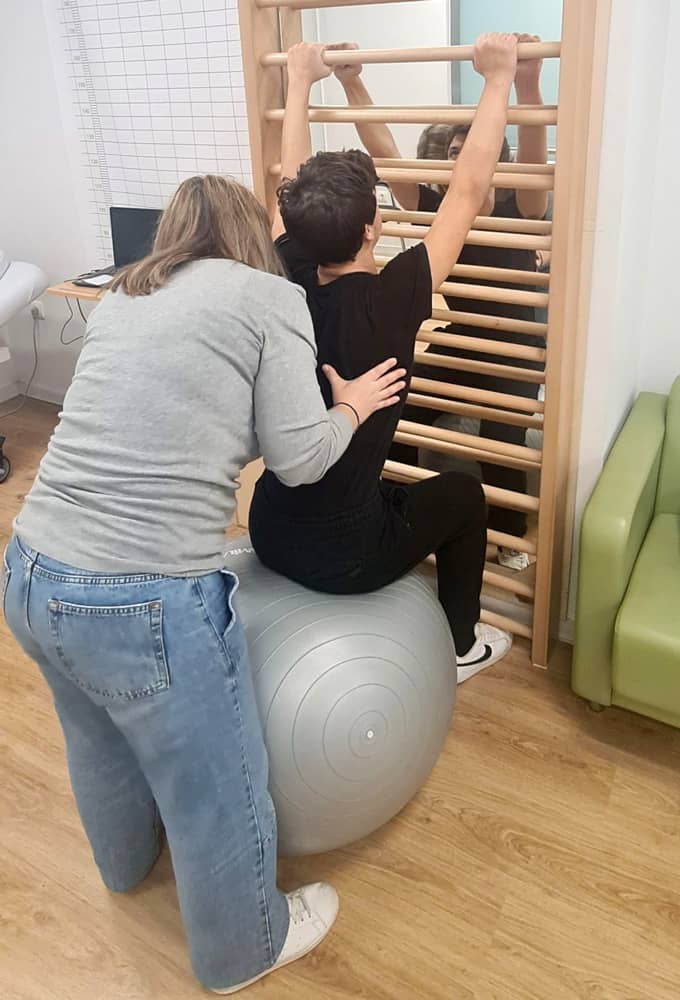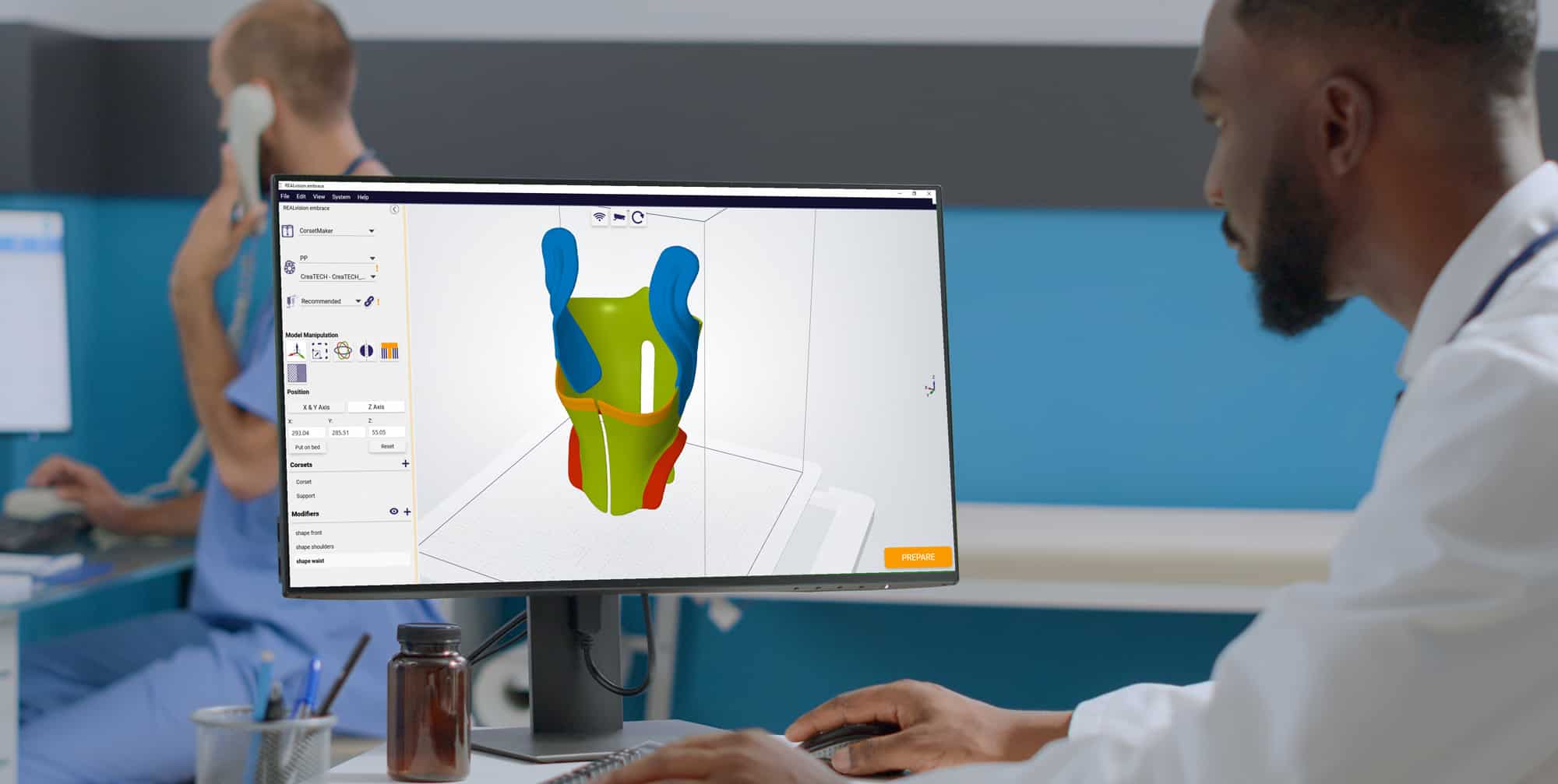Case: Treatment of kyphosis
Ortholife, our trusted partner, incorporates digital transformation into patient care, particularly designing advanced braces for individualized treatment plans. Integrating our Embrace Corset solution enables the development of 3D-printed spinal braces.
This article explores Ortholife’s perspective on addressing adult kyphosis through a blend of physiotherapy and innovative spinal brace solutions.
Why use the 3D-print technology
Let’s dive into the technology Ortholife employs. In their treatment approach, they utilize a 3D-printed spinal brace. Unlike traditional correction braces, the 3D-printed version allows for applying multi-stiffness to specific areas. This innovation enables orthopedic professionals to tailor the brace, making it rigid where correction is crucial and flexible where comfort is prioritized.
According to Eleftherios Samiotis, CEO and owner of Ortholife, “3D-printed braces stand out for their lightweight design, comfort achieved through stiffness variations, functional enhancement via precise thickness adjustments, and accuracy in advanced CAD design.”
Adult Kyphosis treatment with physiotherapy and correction brace
Ortholife bring extensive expertise to treating adult kyphosis, utilizing a comprehensive approach involving the Schroth physiotherapy exercise program and a 3D-printed corrective brace.
Case: Correction
Our first case involved a 15-year-old male patient presenting with a significant 55-degree curvature. Given the typical range of 20-40 degrees considered normal, this constitutes a severe case that could impact the individual’s quality of life. If left untreated, it is anticipated to result in limitations in physical activity, with potential effects on appearance and body image, thereby affecting overall well-being.
To address this, we developed a tailored treatment plan that combines a corrective brace and physiotherapy exercises. Initiating treatment at a young age, before the joints become stiffer, enhances the likelihood of achieving a more normalized 40-degree curvature. This promotes better posture and contributes to a more flexible spine, reducing the risk of future pain.
Case: Posture and pain relieve
The second case involves a 65-year-old female patient who aims to improve posture and alleviate pain. The treatment plan incorporates Schroth physiotherapy exercises, known for their benefits in kyphosis cases. During these exercises, the patient elongates the trunk to promote spinal alignment. A crucial component of the treatment is a custom-made 3D-printed posture brace designed to provide both comfort and the necessary support for enhanced posture and pain relief.
"At Ortholife, we treat adult kyphosis with a holistic approach. Our method combines Schroth's physiotherapy exercises and advanced 3D-printed braces. In one case, we addressed a severe 55-degree curvature in a 15-year-old, aiming for a normalized 40-degree curvature and improved well-being. In another case, a 65-year-old seeks better posture and pain relief through Schroth exercises and a custom 3D-printed brace. Our goal is to transform lives by enhancing posture, flexibility, and overall quality of life."
Eleftherios Samiotis, Ortholife CEO and Owner
The Schroth Method
The Schroth Method is a physiotherapeutic exercise program designed to address scoliosis, a condition characterized by an abnormal lateral curvature of the spine. Katharina Schroth developed this method in the early 20th century to improve spinal alignment, increase postural awareness, and enhance muscular balance to manage scoliosis.
Key features of the Schroth Physiotherapy Program include:
- Individualized Approach: The exercises are tailored to the specific curvature and rotation of the patient’s spine, making it a highly personalized treatment.
- Three-Dimensional Correction: The exercises focus on three-dimensional correction, considering the rotational component of scoliosis, and are designed to de-rotate, elongate, and stabilize the spine.
- Breathing Techniques: Special emphasis is placed on incorporating specific breathing patterns during exercises to optimize ribcage and lung function, promoting improved posture and spinal alignment.
- Mirror and Proprioception Training: Patients often use mirrors during exercises to visually engage with their corrected posture, enhancing proprioception and reinforcing proper spinal alignment.
- Daily Practice: Consistency is crucial, and patients are encouraged to perform the prescribed exercises regularly to achieve long-term benefits.
It’s important to note that a qualified physiotherapist or healthcare professional trained in the Schroth Method should guide individuals through these exercises, ensuring proper form and progression.
Source: Rigo, M., & Weiss, H. R. (2008). The Chêneau concept of bracing—Biomechanical aspects. Studies in Health Technology and Informatics, 135, 303-319. LINK


Digital transformation and sustainability
Where does 3D printing make a difference? Well, it impacts the entire process. In the past, constructing a torso brace involved using a plaster model of the patient’s torso, which presented challenges, especially for younger patients. With the advent of digital transformation, we’ve embraced scanners to create a 3D model directly integrated into our CAD program. This not only streamlines the design and construction preparation but also contributes to sustainability and eco-friendliness in the process.
As Ortholife CEO and owner Eleftherios Samiotis notes, “Consequently, the 3D-printed version enhances correction and provides significantly more comfort.”
In the traditional crafted brace, we use polypropylene material. The significant difference lies in the technology. Transitioning from subtractive to additive manufacturing also signifies a new and more precise level of control over the build preparation process. This shift allows for variations from rigid to more flexible zones, enabling us to prioritize comfort alongside the treatment.
Adult Kyphosis Overview:
Adult kyphosis is an abnormal forward curvature of the thoracic spine, resembling a “C”-shape. Causes include congenital factors, trauma, medical treatments, and osteoporosis. Symptoms range from pain to impacting lung and heart function. Diagnosis involves history, physical exams, and imaging.
Treatment options include conservative approaches like medications, exercise, and braces. Physical therapy focuses on correcting body mechanics. Surgery is reserved for severe cases with significant pain or cosmetic concerns, with potential complications like a flat-back deformity or pseudoarthrosis.
Prevention emphasizes early diagnosis, and management prioritizes conservative measures, turning to surgery when the benefits outweigh the risks. Consultation with a healthcare professional is crucial for personalized guidance and treatment.
Source: Adult kyphosis



